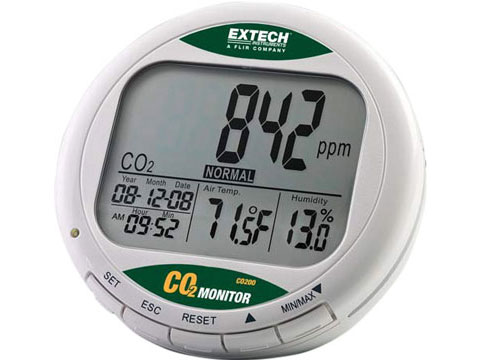Air quality meter checks indoors: mold and gas leaks. Air quality monitoring equipment is essential for ensuring health and safety. Air quality meters meet various industry standards relating to personal safety.
Advanced technology has brought good news to humanity,
But adversely affected air quality as a result of increased gas emissions that harmed the atmosphere. This has led to changes Climatic, global warming, damage to the ozone layer surrounding the earth, disturbing the natural balance between air, water and land.
Clean air contains 20% oxygen and 80% nitrogen. Polluted air contains polluting additives in the form of particles or gases, solids or liquids.
Air pollution in large quantities can cause damage to human health, animals, soil and plants.
The main air pollutants are dust and smoke particles. This is due to CO carbon dioxide combustion, CO2 carbon dioxide: NO nitrogen dioxide, sulfur dioxide S02,
The pollution is affected by the number of particles in the air and their dispersion.
Having large amounts of pollutants can form smog and haze whose health damage is dangerous.
What Are Air Quality Meters?
Contaminant monitoring devices are used to warn of pollutant deviations above the permissible, these are mobile or fixed devices, Some with data loggers make it possible to analyze the information over time. The main parameters measured are: particle amount, carbon dioxide, carbon monoxide, oxygen, humidity and temperature. There are simple, portable and permanent devices that allow everyone from the community to monitor the air quality in their environment.

Air Quality Monitoring Station
An air quality monitoring station is a facility equipped with various instruments and sensors designed to measure and monitor the concentration of pollutants and other airborne particles in the atmosphere. These stations are strategically located in urban, industrial, and other areas prone to pollution to provide accurate data on air quality.
Typically, air quality monitoring stations measure various pollutants such as:
Particulate Matter (PM10 and PM2.5): These are tiny particles suspended in the air, which can have adverse effects on health when inhaled.
Nitrogen Dioxide (NO2): A gas emitted from vehicle exhausts and industrial processes, which can contribute to respiratory problems and environmental damage.
Sulfur Dioxide (SO2): Another gas emitted from industrial processes and burning fossil fuels, which can lead to respiratory issues and contribute to acid rain.
Carbon Monoxide (CO): A colorless, odorless gas produced by incomplete combustion of carbon-based fuels. High levels of CO can be harmful or fatal.
Ozone (O3): Ground-level ozone is a harmful pollutant formed by chemical reactions between oxides of nitrogen (NOx) and volatile organic compounds (VOC) in the presence of sunlight.
Volatile Organic Compounds (VOCs): These are organic chemicals that evaporate easily into the air and can have short- and long-term adverse health effects.